





One of the premeire caudiciform plants for both pot culture and landscaping are the Pachypodiums. These are pachycaul plants from Madagascar and southern Africa. The following is a brief discussion of the genus, including some tips on care and growing, as well as an introduction to many of the species more commonly encountered in cultivation.
(Editor's Note: This article was originally published on March 25, 2008. Your comments are welcome, but please be aware that authors of previously published articles may not be able to respond to your questions.)
Pachypodiums are members of the family Apocynaceae which also includes Adeniums, Oleanders, Plumeria and Periwinkles. Pachypodium means ‘thick foot', referring to the large, swollen caudiciform stems all members of this genus have. They not only have succulent stems but most are heavily armed with thick, stiff spines on the caudex and branches. They are also protected by their toxic sap (true of all Apocynaceaes, though Pachypodiums have clear sap, not the white latex seen running from Plumeria injuries). Leaves are only present on the top of the caudex (like a palm or fern) or on/near the ends of each branch. The palm-like look of some species is where the name Madagascan Palm comes from. The locals call them Half-mense, or Half Mens, an Afrikaans name that refers to their looking like short (half) men from a distance. All Pachypodiums have flowers at certain times of the year. These flowers are simple, star-shaped and somewhat similar to Plumeria flowers- and some equally fragrant.
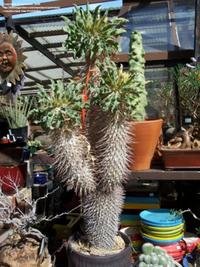
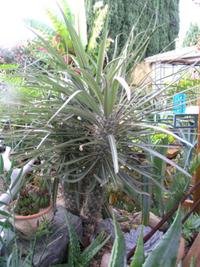 Pachypodium lamereis with 'fat feet'
Pachypodium lamereis with 'fat feet'
this Pachypodium namaquanum looks a bit like a short person, hence the name Half Mens (photo on right by Hellobebe)
In general the Pachypodiums are fairly easy plants to grow indoors, and even easier outdoors in the right climates (warm and dry). Some Pachypodiums even do well in warm, humid climates like those found in Florida (Pachypodium lamerei and rutenbergianum seem to tolerate those humid climates well). There are a few trickier ones to keep alive if one is careless with watering and doesn't know what to look for.
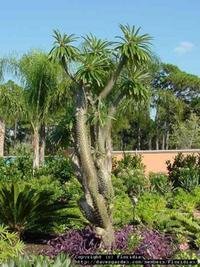 Pachypodium lamerei happily growing in Florida (photo by Floridian)
Pachypodium lamerei happily growing in Florida (photo by Floridian)
These plants are all summer growers and that is normally the time of year they are fully leaved and growing the most vigorously. Some Pachypodium namaquanums in the northern hemisphere seem to retain their southern hemisphere life cycle and try to grow in winter (sometimes predisposing themselves to rot) but this is the only major exception I can think of. Depending on the species, summer is the time of year to water heavily. The more common tree-like species seem the thirstiest drinking up about all the water that can be given them, as long as the soil and temperatures are correct. Most species are deciduous and lose their leaves in winter. This is an indication to stop watering as much, if at all. Outdoor plants in southern California unfortunately often get inundated with heavy rainfall this time of year, but surprisingly this is not a common problem. It seems rainwater is not a problem for most winter dormant succulents, though tap water is something one should definitely avoid using in winter. Depending on yard/pot location some individuals will not go dormant in winter or lose their leaves. Why this is the case I don't know, but perhaps winter rainfall has something to do with it.
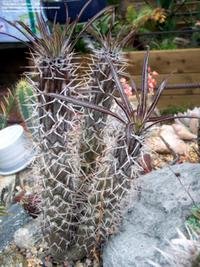

Pachypodium geayi cluster in February on left, and same plant in November on right
Soils have to be very well draining or these plants will rot if kept wet too long in poorly draining soils. There are dozens of excellent soil choices, however, and as long as they contain a lot of porous materials (pumice, perlite or scoria), sand and some organic soil (potting soil, decomposed bark etc.) Pachypodiums seem quite content.
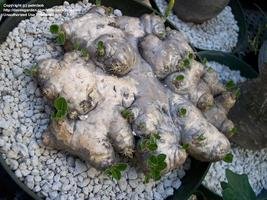
This Pachypodium brevicaule is in pure pumice, for the purpose of rooting, and this is too well a draining soil in the long run... but pumice is an excellent base of any good draining soil
All these plants are demanding of high light situations and suffer in dark, shady locations. Most are full sun plants in the wild. If grown indoors, keep in a southwest facing window ideally (these plants may need to be turned periodically from leaning toward the light and growing crookedly).
Pachypodiums are not very cold tolerant plants. Growing them outdoors in marginal climates like those in southern California can be a risky situation, though some species are much more likely to do well than others. Pachypodium lamerei, geayi, lealii (including sandersii) and succulentum are the most likely species to do well outdoors, with many having success also with namaquanum, densiflora and rutenbergianum as well. Most other species are usually grown in pots as they are either too expensive or too touchy to be reliable outdoor plants in marginally frosty climates. Frosts down to 28F rarely are a problem for most of these cooler-hardy species, but temps down to 26F or below will usually cause severe damage to the trunk/caudex. Last year all most of my outdoor Pachypodium saw 25F-27F and had significant damage to the degree that new growing centers had to start forming at the point of injury. Some proceeded to rot from that point on down. If a Pachypodium gets this sort of frost damage, it is recommended they be removed from the offending climate situations (ie dug up and moved indoors, or move the whole pot indoors if in a pot), preferably in a south-facing warm window for recovery. Apply rooting hormone to the injured area and do not water the plant for a long time. Most will recover and at least one (usually several) new stems will grow from the injured site. Sometimes this is a good thing making the plant more interesting. However it can take years if not forever for the unsightly blemish of the frost-scar to look better.
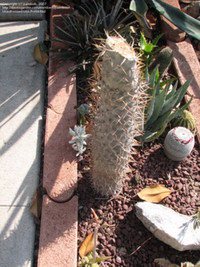
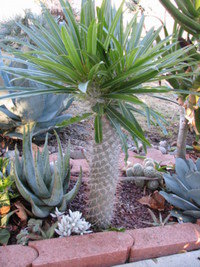
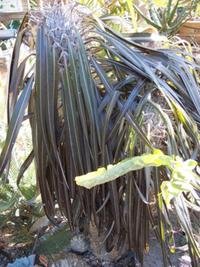
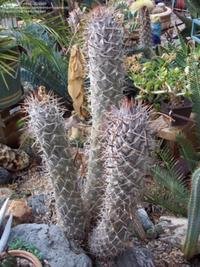
Pachypodiums exposed to cold: on left is the before and after of a Pachypodium lamerei frozen to the point of rot (top had to be cut off), but then two new heads grew back; Pachypodium geayi with a sudden freeze damaging all the leaves, and then the after shot of the leaves haven fallen off (they all grew back)
Fertilizer is not usually needed if one is going to repot their plants every 2-3 years. But otherwise a gentle liquid fertilizing in summers is probably not a bad idea, and may promote flowering. It is recommended to use a standard fertilizer that has even quantities of all three major nutrients, or perhaps a tad heavy on the phosphorous in summer. Some provide extra potash or potassium in the summer and fall to help improve winter hardiness (a common practice with Plumeria growers) if growing these outdoors in marginal climates.
There is little unique to keeping these species in pots that differ in any way from keeping other succulents in pots, except remember these get tall and the trunks are full of water, which can make them very heavy, which, if not kept in a heavy enough pot, will make them easy to tip over. This is even more important if growing a large crested plant as these become very top heavy.
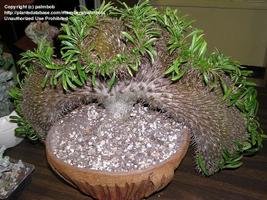
Sometimes keeping a plant in a pot is the very best thing, as in this Pachypodium lamerei crest... in the ground the edges of this crest would be underground
The species:
Pachypodium lamerei- this is by far the most commonly grown Pachypodium in cultivation and the one most refer to as the Madagascar Palm (though several are called that). It is one of the faster growing species, obtaining heights around 20' in its native lands (southern Madagascar) and is a thick-trunked, intensely spiny shrub/tree with 0 to several branches. The spines are in groups of three with two long ones next to each other and a shorter one right above them. They are usually about 1" long, stout and fairly sharp. In this species the spines tend to jut out nearly parallel from the trunk and not at the sharp angles the spines of Pachypodium geayi do. The leaves are lancelote and bright green with a pale yellow midrib. Branching usually occurs as a result of injury (trauma, frost damage, insect damage etc.) so I supposed if a plant lead a particularly charmed and protected life, it might remain a solitary stem, topped with a crown of leaves. And in fact, this is often how indoor plants grow as they seem to be injured less often than those grown outdoors. Crested forms are fairly common but still sought after. However, supposedly most crested forms have very limited life spans (at least the crested portion is supposed to) though mine is fine after 3 years and shows no sign of aging, other than the severe freeze damage it got last year. Flowers occur usually in early summer and are white with yellow centers and smell great. This species seems to like a lot of water in the summers and I have yet to discover its limits in tolerating lots of water. It is one of the easiest succulents to grow, both in the ground and in a pot. Just plant it and that's about as tough as it gets. Pachypodium lamereis do well in humid climates like those in Florida, and it may even prefer such climates (the Florida-grown palms always look great and seem to grow much faster than the ones in arid climates).
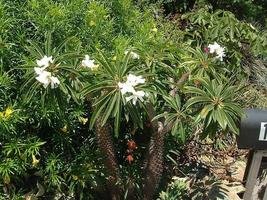
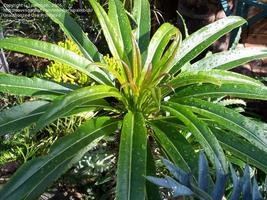
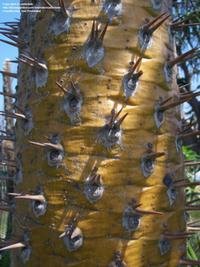
Flowering outdoor grown plant in summer, southern California; close up of mature and newly growing leaves; stem detail showing spine arrangement
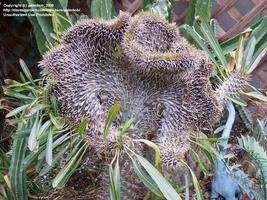 Crested plant outdoors in early winter. Crests of common in this species
Crested plant outdoors in early winter. Crests of common in this species
Pachypodium geayi- this one is also called the Madagascar Palm, and is also from Southern Madagascar, though from a more arid climate zone there. In general appearance it is somewhat similar to Pachypodium lamerei, but tends to be even beefier and taller (at least here in California). The primary difference between the two is this species has thinner, greyer-green leaves that are less shiny and have a reddish midrib. Also the spines on this one, also in groups of three, are more equal in length and all point away from the trunk at sharp angles. This plant seems happier in a drier climate than in the humid ones Pachypodium lamerei seems to prefer (though both grow rather well in both climates). Flowers are quite similar in both appearance and smell. I find this plant just about exactly as hardy and fast growing as Pachypodium lamerei, but takes longer to flower.
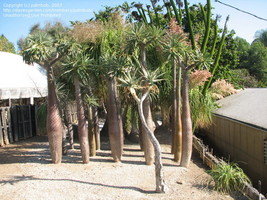
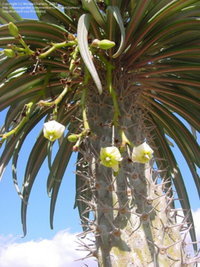
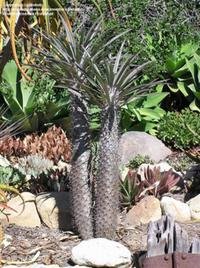
Colony of old plants at nusery in Southern California; shot of flowering plant (photo by MichaelCharters); pair of plants in private garden
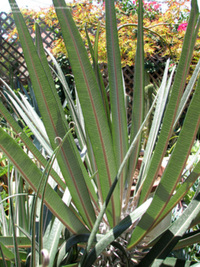
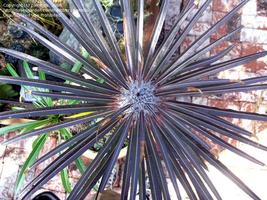
two shots of the leaves of this species (Pachypodium geayi)
Pachypodium rutenbergianum- this is the third and last of the giant species of Pachypodium and is the largest and fastest growing of them all (up to 30' in the wilds of Madagascar). However it is also a bit less hardy and touchier, so in marginal climates it might never attain its true potential. The only truly large ones I have seen were in Miami where it really never freezes. My plant is doing pretty well against a west-facing wall, though last frost did kill off the top 3-4" of each branch (causing it to branch many more times). Pachypodium rutenbergianum is a slightly less caudiciform-looking plant keeping a slimmer figure. It also has narrower leaves and less thick, too. The leaves are somewhat shiny dark green with a pale, nearly white midrib, and they recurve a bit. This species is reliably deciduous unlike the above two which will sometimes eke through a winter with some leaves left on. Even in a warm tropical climate like Miami this is a regularly deciduous plant. Spines are paired, short, stout and look a bit like rose thorns. Their arrangement along the trunk and branches seems somewhat random but like all the other Pachypodiums, sit on either side of the leaves (or leaf scars once they fall off). Flowers are white with pale yellow centers, but seem to form while leafless in winter, instead of in summer like the above two.
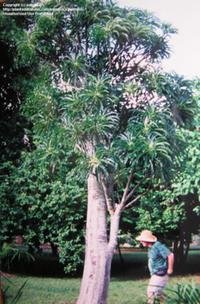
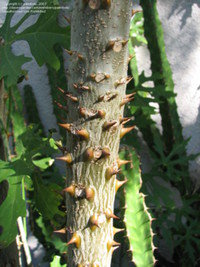
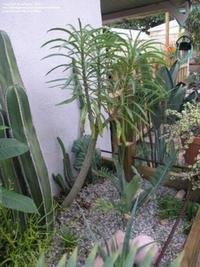
Mature plant in Miami in summer, and then, flowering, in winter; young plant in southern California garden against a west-facing wall

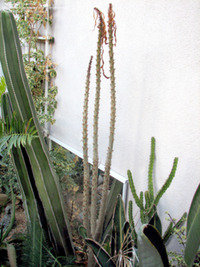
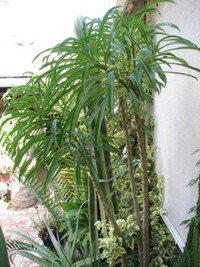
close up of spines on young plant; my garden plant after freeze last year, and then this summer (recovered)
Pachypodium namaquanum- This is probably the largest of the southern African species and the one originally referred to as Halfmens. In Africa these plants can grow as tall as 8'-12' but they are pretty slow growing even there. In cultivation they rarely get taller than 3'-4' feet. Branching occurs but is rare and few plants have more than 2-4 branches. Most plants resemble heavily spined pillars, often the same diameter or slightly thinner at the top as at the bottom. Old plants develop a massive girth and one can understand why they were referred to as half men, half plants. The leaves of this plant are pale green and characteristically fuzzy with curious undulating margins. It would be difficult to confuse this species with any other. Flowers are a deep red and form at the top, center of each stem in tight bunches. Spines generally are grouped in threes, but are thin, long and tend to flare a bit outwards. The third spine is below the two paired ones in this species (opposite to Pachypodium lamerei). Hardiness of this species seems to be about halfway between the two common large species and Pachypodium rutenbergianum. But it is very prone to rot if watered heavily in winters, and even rain water can get this one to rot if not kept in very well draining soils and kept in full sun. Though large, old plants are wonderfully impressive landscape specimens, most grow this species in pots.
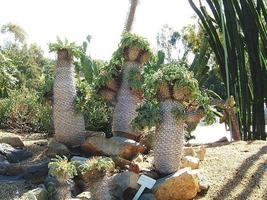
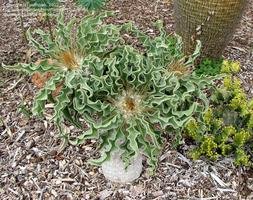
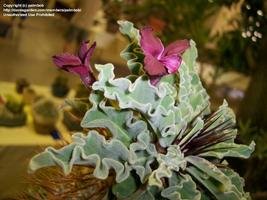
Excellent colony of plants in southern California nursery; top view of plant in garden; flowering show plant, showing the fuzzy leaves
Pachypodium saundersii (aka lealii var. saundersii)- The common name of this species is Star of Lundi though I couldn't say why. It is a moderately fast growing species from southern Africa (Zimbabwe and Namibia) up to 4' tall eventually. It is a highly branched plant eventually forming an irregular and somewhat awkward looking shrub. The leaves are smooth, bright, light green and shiny with a thin, white midrib. Leaves exist all along the branches of this species, not just near the growing meristems. This species has paired spines somewhat irregularly spaced along the stems and branches, with the spine size smaller on smaller branches. Flowers are white in the late summer to fall and plants as young as 4 years can flower. This is a popular species because it is so easy to grow, but it is probably one of the least ornamental of the genus, having a less-than-impressive caudex often, and growing somewhat sloppily. However, if deftly pruned and with patience, it can be grown into an attractive plant. Cold hardiness is mild with damage occurring just 2-3 degrees below freezing.
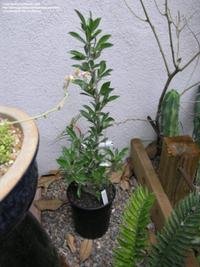
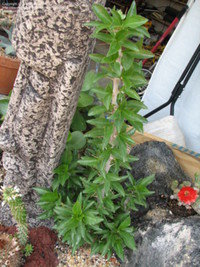
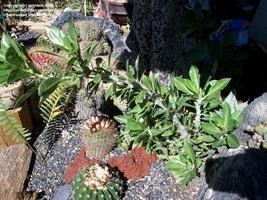
Progress with my own yard plant, first in a pot, then in the planter, and then growing all over the place (fast grower!)
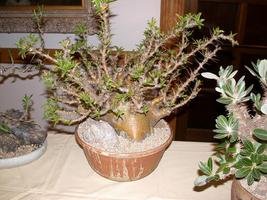
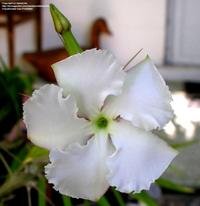
show plant on left with a pretty good caudex flower detail (photo by IslalndJim)
Pachypodium lealii (aka lealii var. lealii) - this closely related plant is slightly similar in form and spination, but the leaves are less shiny, to nearly fuzzy. This species is a bit less branched, but similar in overall shape to Pachypodium saundersii. Spines stick out close to each other in groups of three perpendicularly from the stem, with two long ones below and a much shorter one above. The flowers have distinct pink throats and are smaller overall and more tubular in shape to those of Pachypoidum saundersii. Flowering is generally in early to mid summer. Cold hardiness is pretty good down to about 26F at which point new tender growth is damaged.
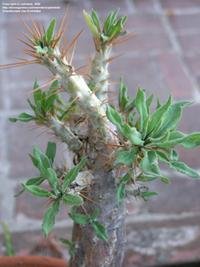

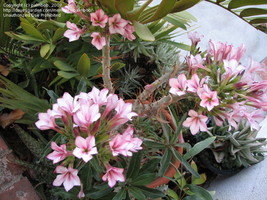
my own plant in pot close up of the leaves, spines and new growth in spring summer flowers
Pachypodium succulentum- this is probably the last of the ‘hardy' Pachypodiums, that at least can be grown reliably in the ground in southern California. It is nearly a geophyte with its huge, bulbous caudiciform roots being all underground in nature (southern Africa). However, in cultivation most grow it with the majority of roots above ground for effect. Branches are somewhat soft, twisted and irregularly spiny (thin ½" paired spines). Leaves tend to form only near the ends of each branch (in regions of new growth), and they are thin, short (1"-2" long) pale to mid-green, slightly shiny with a pale midrib, and often curled a bit. Flowers are in late spring to early summer and are tiny, white with pink midribs.
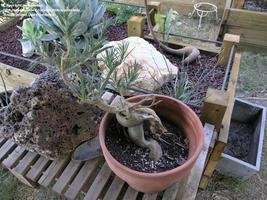
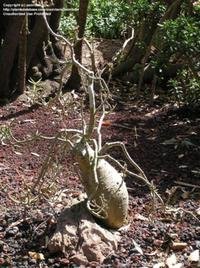

my outdoor plant several years back in summer, and recently in winter Nice, happy specimen in botanical garden in winter southern California on right
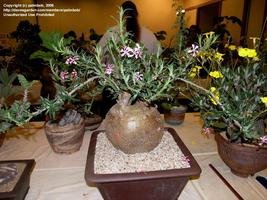
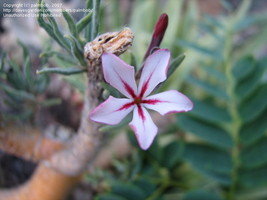
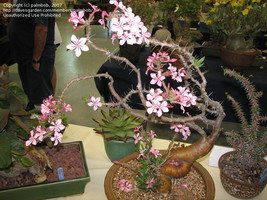
show plants on right and left photos, and a flower of my outdoor plant in the middle photo
Pachypodium bispinosum is another southern African geophytic species with similar form in terms of branches, spination and leaf shape. However this species has a massive caudiciform trunk, less twisted and undulating like Pachypoidum succulentum. Leaves are bit wider and longer and flowers are larger, funnel-shaped with pink throats. Cold hardiness in this species is less clear, but it would not surprise me to find it similar to that in succulentum.
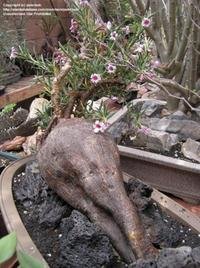
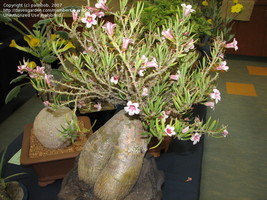
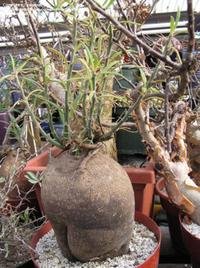
two show plants, both in bloom, and then some plants for sale in a southern California nursery (Pachypodium bispinosums)
Pachypodium densiflorum- this is probably the last species to be discussed that has a chance of being grown as an outdoor plant in southern California. Mine has been in the garden for over 3 years and though it did get badly damaged last year during the freeze, all Pachypodiums were equally fried last winter. It recovered quickly (better than Pachypodium rutenbergianum did) and is branching a lot now (in response to the freeze damage). This species is a Madagascan one, as all the below species are, and not all that easy to tell from Pachypodium rosulatum. It has soft, slight fuzzy, ovoid paddle-shaped pale green leaves with white midribs. Spines are paired, short, stout and tend to fall off on the older stems. This is one of the most attractive ornamental plants having a very large, smooth, shiny caudiciform trunk that tends to gently but rapidly taper into several short, thinner but still stout branches- all upright. Flowers are in late summer to fall on long stalks far above the plant. They are relatively large, deep yellow to gold with a characteristic white conical shape at the center of each flower.
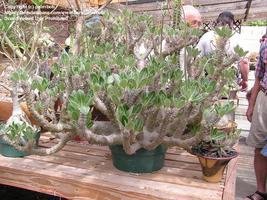
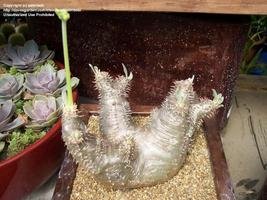
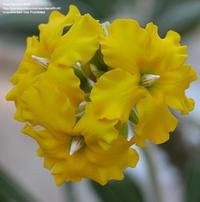
Pachypodium densiflorum in collection, and in a plant show (leafless) Flowers (photo by RUK)
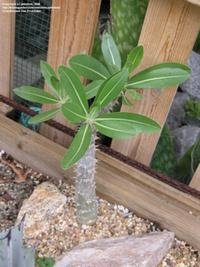
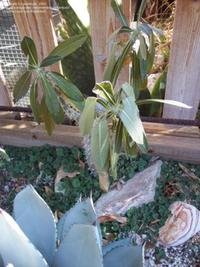
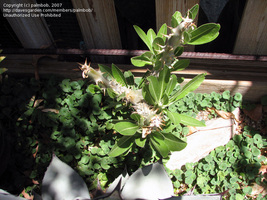
my outdoor plant in summer one year, winter last year (usuasual freeze) and recovered this summer again
Pachypodium rosulatum- this plant is similar in overall shape to Pachypodium densiflorum with the large, smooth caudex and the slow tapering to smaller branches. However the leaves are shiny and darker green and slightly narrower. Also the flowers are on shorter stalks and a lightly, brighter yellow without the center cones. Flowering is in mid summer. This plant grows maybe up to 2' tall. There are several varieties of this plant, and Pachypodium cactipes is thought to be a synonym as well.
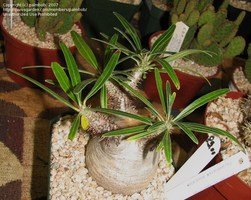

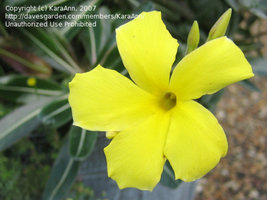
Pachypodium rosulatum in private collelction (photo by RWhiz) and for sale at CSSC event, and lastly, the flower (photo by KaraAnn)
Pachypodium horombense is another low-growing wonderfully caudiciform species with a fat trunk that tapers elegantly to the branches. This species has somewhat stouter spines, but is overall quite similar. Leaves are tear-drop-shaped, thin and slight wavy to flat with a prominent white midrib. Flowers are quite large (up to 2" diameter) and bright yellow.
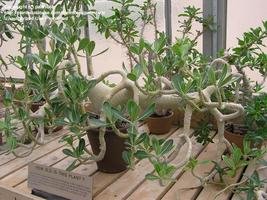
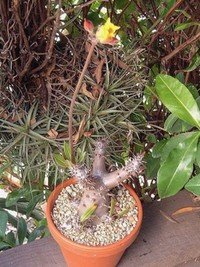
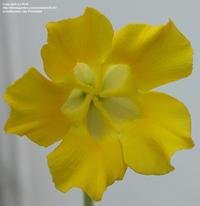
Pachypodium horombense in the Huntington as a very old plant; younger plant (photo by RWhis); Flower (photo by RUK)
Pachypodium brevicaule is a very unusual plant, rarely growing over 2" in height and looking a bit like a plop of molten silver lava. Leaves are short and tear-drop shaped, light green with a light midrib. Spines are varaible with some plants having almost none. Flowers are bright yellow and on short 3"-5" peduncles held far above the rest of the plant. This species has become increasingly popular recently and more and more can be found for sale at plant shows and nurseries. It used to be quite rare. It is one of the most touchy species really preferring year round temps about the same, and the same goes for watering. This is not one to over OR underwater (don't let it completely dry out). Not cold hardy at all.
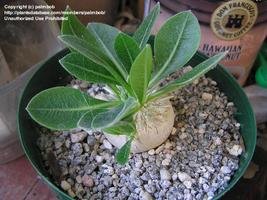
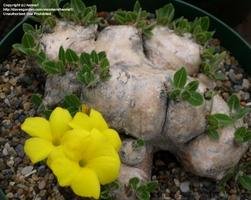
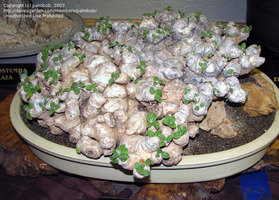
Pachypodium brevicaule young plant Flowering older plant very old show plant
Pachypodium baronii is a nearly spineless species (spines are paired but very small and tend to smooth eventually). I have not had any luck trying to grow this species outdoors as it is very frost tender. But if one has a greenhouse or warm place for this plant it can grow up to be a 3' tall plant with a bottle-shaped trunk and brilliantly red flowers in spring.
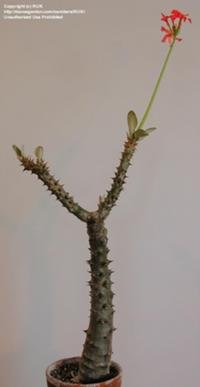
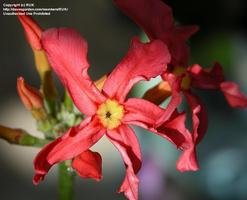 Pachypodiym decaryi and flower (photos by RUK)
Pachypodiym decaryi and flower (photos by RUK)
There are about 10-15 other species of Pachypodium, all worthy of pot culture as most are wonderfully ornamental caudiciform plants. These remaining species are still pretty rare in cultivation, though they are showing up in cactus and succulent shows with increasing regularity. Someday one may easily be able to obtain all 23 species and have the ‘complete' collection of these wonderful caudiciforms.
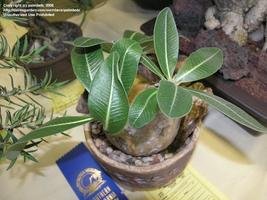
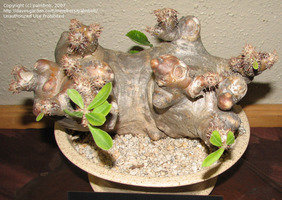
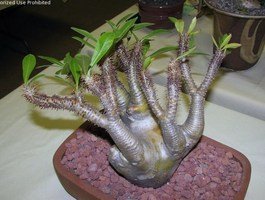
Pachypodium eburnum Pachypodium makayense Pachypodium mikea
Copyright © www.100flowers.win Botanic Garden All Rights Reserved